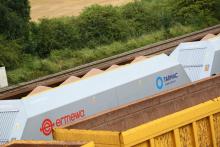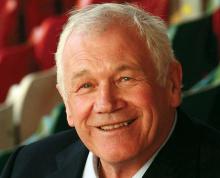
Efficient shipping and logistics can cut aggregate business operating costs massively. Guy Woodford reports on some of the latest industry thinking and technology in this area.
For
“The challenges are retention of our owner-drivers and the retention and recruitment of drivers on our own vehicle fleet. If you go over to Lincolnshire, for example, it’s easier to recruit drivers than if you’re based nearer urban areas where there’s a bigger offering to people.
“For example, at Castle Donington, where our main office is, you’ve got an M&S distribution hub and DHL. You can drive an artic lorry in a collar and tie from Castle Donington to Birmingham for the same money you can get from waiting on a load of asphalt at six in the morning.
“I like our team to make money. If they’re making money, I’m happy. What you’ll find with hauliers is the more money they make, the more they reinvest in their vehicles and the better service they offer our customers.
This is achieved by having a well-presented truck profile which is reliable, looks right and gives the right perception of the company to our customers” Hall said that during his time as Breedon England’s CEO, he’s always had the haulage workshops reporting directly to him. “I’ve also chaired the haulage meetings between the owner-drivers and our drivers,” he continued. “This gives you a grip, but most importantly it gives you a feel for what’s happening.
When you’re looking at owner-driver haulage accounts and your own haulage driver accounts, you can benchmark between the two. Then when you’re sat in front of them you can manage their expectations with knowledge.”
While Breedon Aggregates uses technology to monitor where its hauliers are at any given time, Hall says that telematics are not a major feature of their day-to-day logistics.
“With any IT system you put in a plan for it, but the day unfolds with traffic congestion, accidents, breakdowns and weather and you’ve got a human being that needs recalibrating. You’re better off taking that [IT system] layer out.
“I think it’s about having class people, well remunerated and trained. A lot of people try to overcome the fact that they won’t remunerate and have the right people by using an IT system that never actually works in our business.”
Of how logistics operations in the aggregates industry are likely to change in future years, Hall said: “I think the [on-highway] weight limits for articulated vehicles will go up. There will be a move to improve artic haulier safety, aimed at stopping them overturning. You will also see better certification and training of drivers, but as part of that we as an industry need to realise that we have got to pay more to enjoy those talents.”
Chris Swan, senior manager rail and shipping at
“From the Thames Tideway Tunnel, to the Northern Powerhouse, to schemes such as HS2 and a possible Crossrail 2, the UK’s infrastructure pipeline dominates the headlines – good and bad. What attracts considerably less airtime is how we will build these once-in-a-generation projects and ensure we get the required materials – in the right place, at the right time,” says Swan.
“There is now an expectation from many in the construction sector and policymakers that rail freight can play an integral part in transporting the materials needed for these projects. It’s a view that Tarmac supports and encourages. As one of the UK’s largest users of rail freight, we believe that building capacity into the network and improved access is vital to helping deliver Britain’s infrastructure ambitions.”
Swan says that while there’s been an upward trajectory in the volumes of construction materials transported by rail in the last decade, expansion has been stifled by the UK’s declining steel and coal markets which have led to reduced freight capacity in some areas. Equally, in the south-east – where many infrastructure projects are located – Swan states that high-volume passenger routes continue to bring competing capacity challenges for the rail freight network.
“Achieving modal shift and making rail freight the preferred transport solution requires the rail and construction sectors to take collective steps and act in a cohesive manner to seize the opportunity,” argues Swan.
“Cross-industry partnership between rail network operators, freight companies and materials providers is key and they all must have an excellent understanding of the National Infrastructure Plan and its likely impacts for rail freight. “Partnership must bring together and deliver coordinated planning, quality network capacity and investment in terminals to help move materials on and off the network more easily.
“Last year, Tarmac carried out a national strategic review of its rail infrastructure with an aim to deliver year-on-year increases in rail freight tonnage. The company currently transports nine million tonnes of material by rail across the UK each year, which supports the reduction of carbon from road vehicles and our plans to reduce transport CO2 by 10% per tonne by 2020.
“We’ve forged new long-term partnerships with four rail providers and have modern, efficient wagons right across our UK network that will help drive freight expansion and develop a supply chain that understands the requirements of a growing infrastructure sector. We’ve already started to implement changes to meet growing customer demand,” explains Swan.
Together with other members of the
In addition, improving connections between sites and depots, such as the rail link between our Arcow and Dry Rigg quarries and the Settle to Carlisle railway, Tarmac is continuing to invest in people and skills. Swan argues that it’s critical that the firm has expert logistics teams with the right knowledge in place to develop and manage more high-tech trains with enhanced capabilities.
“Britain has a fantastic opportunity to make fundamental, lasting and positive changes to its infrastructure,” continues Swan. “We also have a major opportunity to build these new projects differently with an optimised and efficient rail freight network to deliver materials at the right time, and with a lower carbon footprint. So it’s critical that all partners involved in the freight network work together to deliver, and speak with one voice to raise the profile of the requirements we have for this vital supply network.”
Fast pit stops are crucial in today’s motorsport. But the daily hauling race for competitiveness starts way before you enter or exit the pit lane. The right planning strategy and real-time data insights can help to maximise your road performance, argues German software logistics solution specialists INFORM.
Information technology has hit the road: GPS, telematics, tracking & tracing, smart routing, etc., have become an integral part of bulk material distribution by truck. And many aggregate and concrete suppliers combine real-time data insights into their logistics planning software in order to find the right balance between transportation costs and customer service level.
INFORM says planners and dispatchers face a high variability of demand, heavy onsite traffic during peak hours, limited availability of trucks, driving and working time regulation limits and many other restrictions. Conventional scheduling software packages can be a practical tool for the daily routine.
They automatically copy order data from the ERP system, provide user-friendly graphical interfaces to help assign trucks to loading points, calculate schedules and turnaround times, or visualise routes on maps. But with a larger truck fleet on the road, numerous plants, depots and delivery sites spread across a region, a large amount of information has to be handled in order to find a set of good schedules.
A giant leap forward in planning technology is the use of intelligent optimisation software packages. They are equipped with algorithms that analyse a virtually endless number of scheduling decisions in real time and identify those that are ideal for minimising costs and maximising service quality – based on the business criteria defined. Figure 1 (Transport Planning: Man against Machine) compares real-world data from a typical working day in the aggregates industry (Europe) – before and after optimisation.
This race, “manual planning against intelligent software planning” shows that empty mileage is down by almost 9%, and the number of loads per truck per day soared by 30%. But most impressive is the number of trucks: 19 instead of 28 (Note: for the same quantity of deliveries). Besides the financial benefits this will also help to reduce off-site and on-site traffic and contribute to a safer working environment.
Maintaining adequate cement bin capacities and aggregate stockpile levels is important for any concrete producer.
Inbound raw material hauling and stock level planning is often only based on static order book information (ERP) while outbound concrete deliveries are coordinated by means of a transport planning software based on real-time information. Combining both into a Material Replenishment Process (MRP) can streamline the entire supply chain. By updating the inbound materials requirements every 5 to 15 minutes based on live concrete deliveries, all inbound deliveries can then be rescheduled by the optimisation software to avoid unnecessary traffic during peak hours, to prevent oversupplies and waiting times or more critical stock-outs, and to maximise the truck fleet’s utilisation. For those who work under pressure, quick action is needed.
Dispatchers often have no time to consider all constraints and business rules that may apply (e.g. preferred haulier list, contract profitability, haulier quota, etc.). Optimisation software stays calm and focused. All rules can be weighted within the software using scaling factors and will be taken into account by the optimiser. This ensures that planners will always find the right set-up when allocating transport orders to hauliers and vehicles. They can also compare several scenarios for the same data set by simply changing the scaling factors and objectives. Hauliers can log onto the system and accept or reject jobs that were assigned to them.
Vehicle breakdowns and traffic holdups are a nightmare for any race car driver. Even small incidents can mean the difference between finishing on the podium or scoring no points at all. On-time delivery and customer satisfaction are a dispatcher’s equivalent performance indicators. Disruptions will affect the efficiency of the operations if no countermeasures are taken. Optimisation software reviews and adjusts all planing decisions in real time. It also allows the dispatcher to select whether service levels can be met with fewer vehicles or increased with the existing fleet.
Strategic network planning enables optimisation of the distribution of bulk material in terms of time to market and cost per unit moved. By using real time optimisation software for network wide transport planning, resources can be used on the day in a more efficient way. In a smart network, ship, rail and road resources can be shifted where required, preventing idle times in some locations and work overloads in others. An integrated approach allows to update all plans across the business within seconds.
Cemex’s new pop-up rail depot
A new pop-up rail depot in Warrington, county Cheshire, is the latest
The temporary Warrington site has been created using a readymade weighbridge and office with a generator and installed on available land next to the West Coast main line.
The aggregates are transported in box wagons, unloaded with a grabber and stockpiled on site, awaiting local transportation by road to concrete plants and construction sites.
“A pop-up rail depot can be installed in weeks rather than months and gives the flexibility to move aggregates from quarries to areas where they are needed, especially in the short-term. So with the right piece of land close to the rail network you can create a depot,” said Mark Grimshaw-Smith, head of Cemex Rail and Sea“Rail has considerable economic and environmental benefits compared to road transportation with significant CO2 savings and on busy roads, a major time saving,” continued Grimshaw-Smith. “In 2015 we transported 2.3 million tonnes by rail equivalent to 80,000 truck movements. And now we can establish a depot relatively quickly, we would like to establish more freight paths taking even more trucks off our busy roads.”
Currently, Cemex operates 14 receiving depots serving key areas of the country with material from three despatch points: Dove Holes quarry in Derbyshire; Shap quarry in Cumbria; and Cardiff. Rail volumes, says the company, have grown by 25% between 2012 and 2015.







